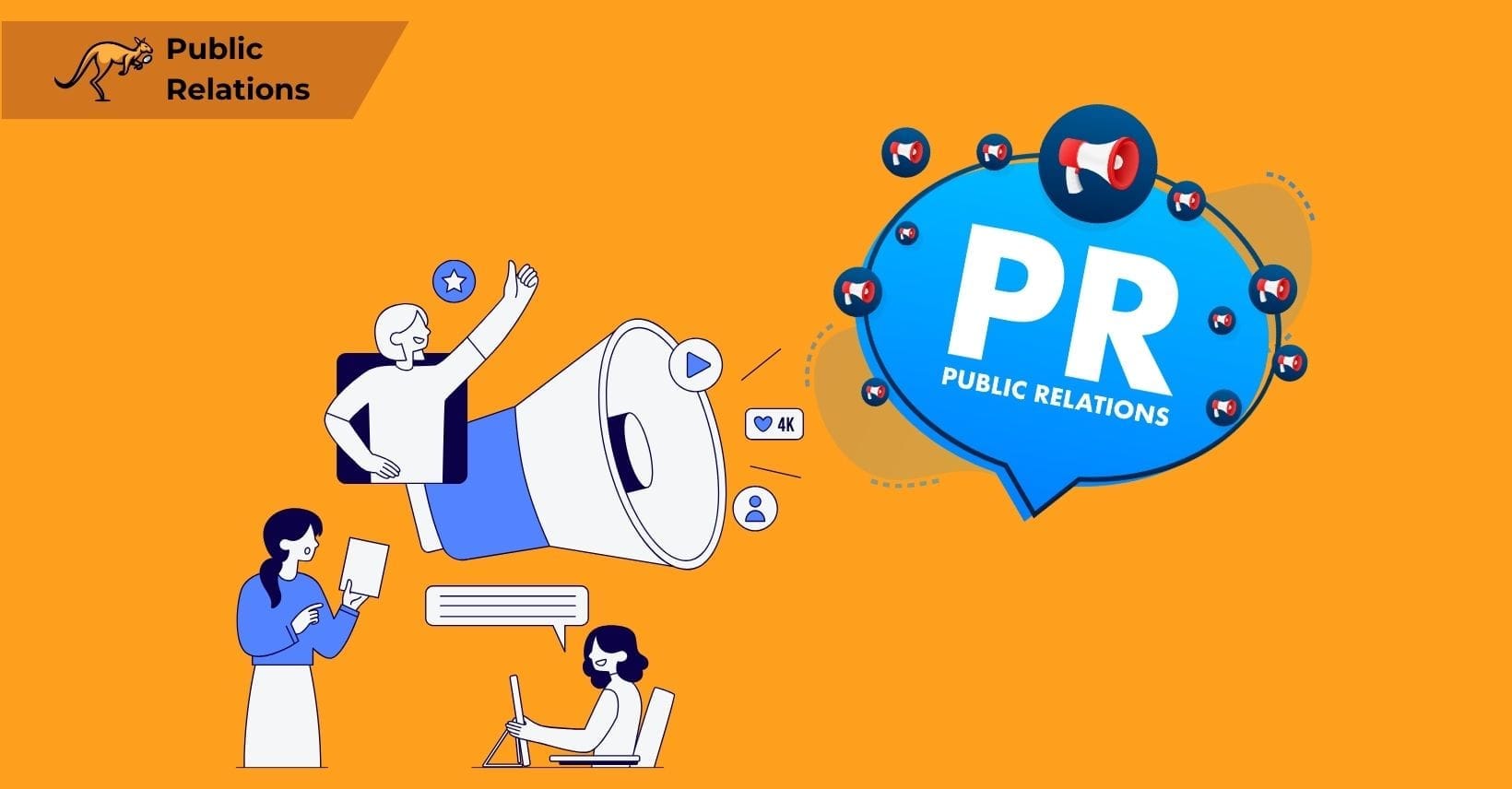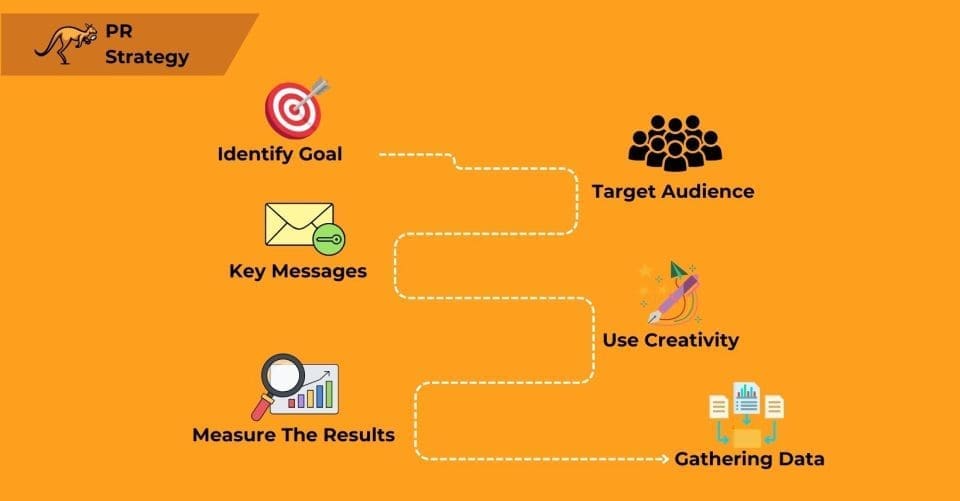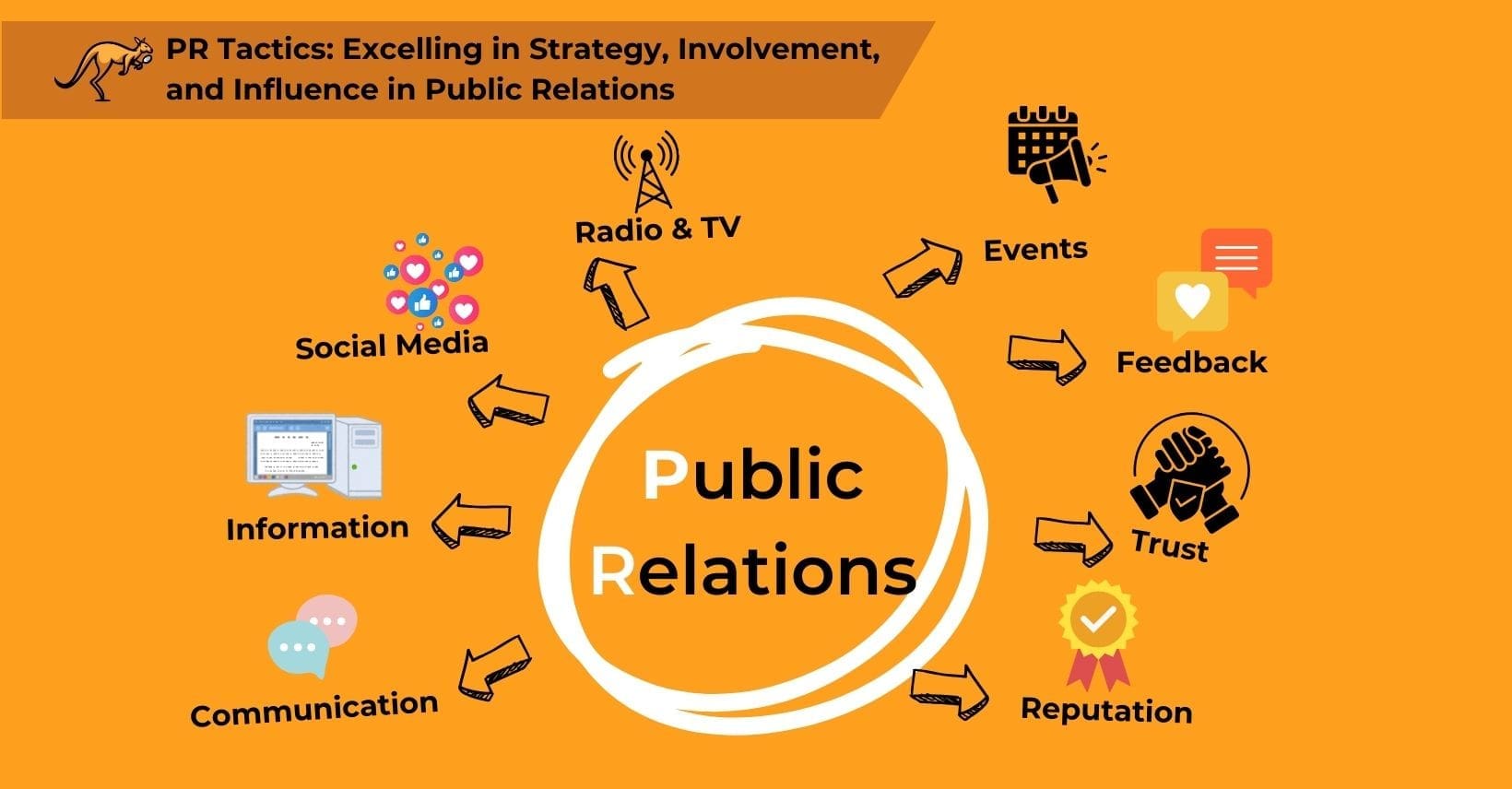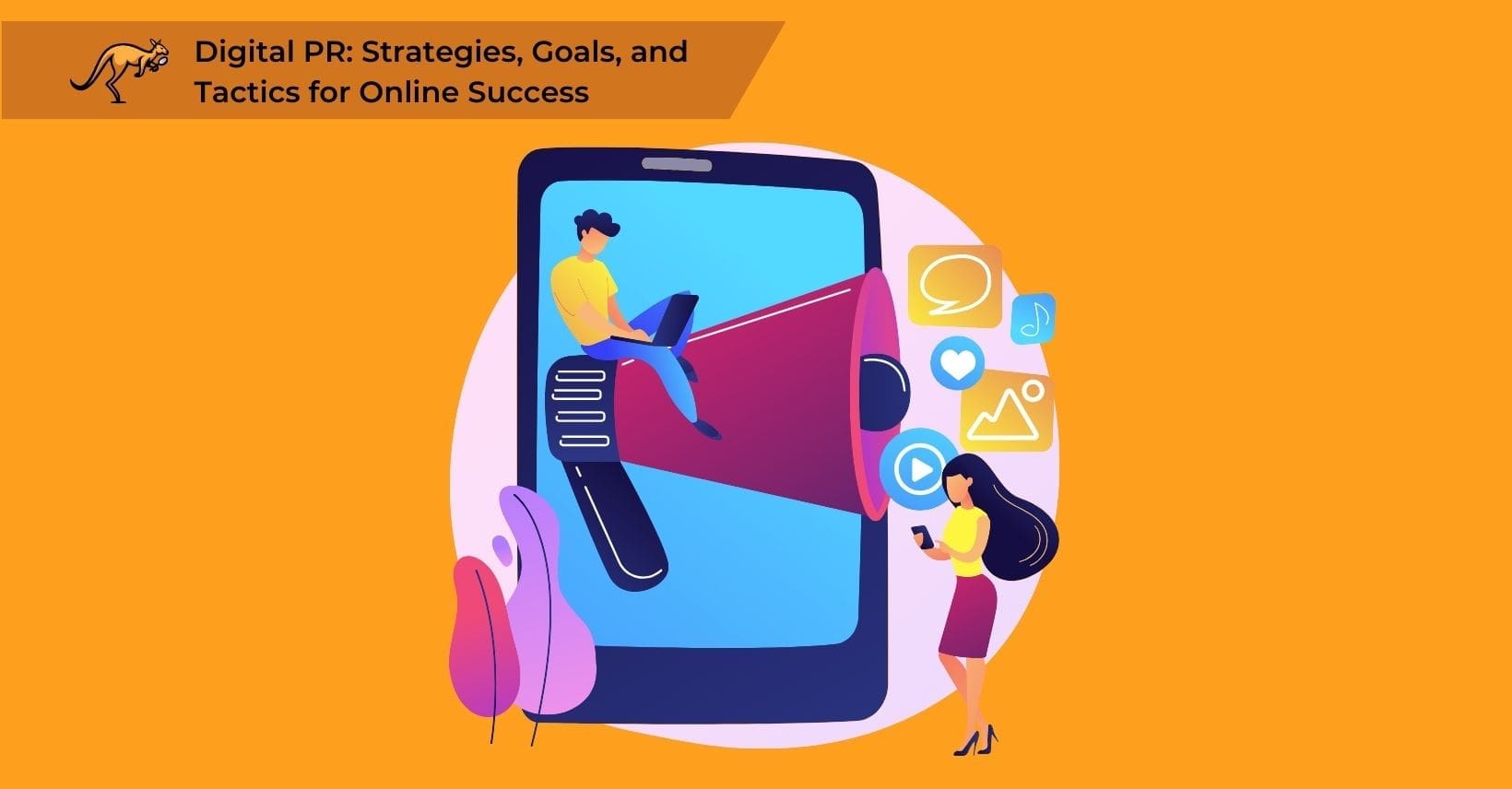Public relations (PR) is pivotal in shaping a business’s reputation, especially as more businesses transition to online platforms. Good PR strategies influence customer perception and can be the difference between success and failure.
Contrary to the common misconception that PR is only necessary during crises, effective public relations is an ongoing effort.
In the digital era, companies employ various tactics to enhance their online presence and connect with broader audiences.
Exploring the workings of modern PR unveils the strategic applications that maintain and improve business relationships. As we examine these dynamics, it’s natural to wonder about the foundational elements of public relations.
What is Public Relations?

Public Relations (PR) involves managing how information about a brand is communicated, impacting both the brand’s reputation and consumer perceptions.
This management includes disseminating positive stories, like securing articles in major online media outlets, and handling negative incidents, such as reporting on product faults.
Effective PR strategies are essential for brands aiming to expand their reach, enhance brand awareness, foster customer loyalty, and establish a competitive edge.
As brands consider these goals, the underlying importance of a well-considered PR strategy becomes evident, setting the stage for deeper exploration into its pivotal role.
Why a PR Strategy Matters
Public relations fundamentally aims to enhance brand visibility and mend any disruptions in trust with the audience.
The core of effective PR lies in constructing a strategic framework that governs interactions with the target audience through marketing initiatives, direct customer engagement, media relations, and broadening brand appeal.
Businesses depend on such strategies to shape public perceptions through their responses to feedback and collaborations with partners and influencers.
Moreover, PR is not merely about organizing large-scale events but also involves careful management of media relations and brand promotion activities.
As we explore these foundational concepts further, the next step involves dissecting the creation of a PR strategy that supports these objectives.
Creating a PR Strategy

The challenge in formulating an effective PR strategy lies in the complexity of public relations itself. Different brands and businesses have distinct needs; a strategy effective for one might falter with another due to variations in influential factors such as market dynamics or consumer behavior.
Consequently, PR strategies cannot merely replicate successful tactics from one campaign to another. Recognizing patterns in successful strategies can, however, provide valuable insights. As we examine the foundations of PR strategy, we approach the pivotal task of defining clear objectives that will guide the entire strategic process.
Identify The Goal
PR tactics need a goal. Maybe you want more media coverage to raise brand awareness or need to host press releases for crisis communications after a major PR disaster.
Public relations professionals always start with the goal in mind. Your PR efforts need to be in service of a specific goal – building general goodwill does not hurt, but it also does not generate leads or provide the crisis management options that you need.
Be Realistic
The best PR tactics focus on achievable and realistic goals. Just like pushing your marketing strategies too far, it is easy to overestimate what your PR tactics can do.
Public relations is about swaying opinions in your favor, but it can’t usually completely rewrite a company’s reputation in a matter of days.
Be Relevant
This does not just mean that a press release has to be relevant to your most recent product – you want your PR tactics to make sense with your long-term business goals.
Is the PR campaign idea you have had actually going to have an impact on your marketing in the near future, or are you arranging a PR stunt that will only serve to promote itself and not actually benefit your business overall?
Stay Measurable
Having measurable metrics can be invaluable when setting PR goals. For example, a product launch could be measured by the number of views a page gets or the number of viewers on an official product launch live stream.
You can’t know if you have created engaging content unless you can track the engagement, so having access to measurable data really helps. Even just website visitor counters or social media stats can make a difference if you want to see how far your news publications spread.
Be Specific
Know who you want to target, which partners (such as influencer marketing partners) are appropriate, and which media outlets would be the best for anything you are having spread around.
You want your PR strategies to follow a solid plan, with every individual PR tactic properly understood and planned out. This means your target audience, your media contacts, and the media channels that you are going to use.
Be Fast Enough
Timeliness is essential in public relations, where the effectiveness of tactics such as press conferences hinges on their prompt execution.
Delaying PR actions can often render them less sincere and effective, particularly when they are intended to interact with customers—a common target for most PR strategies.
Recognizing the right timing is essential not just for immediate engagement but also for maintaining credibility and trust among your audience. Moving forward, understanding who your audience is becomes a pivotal next step, shaping how and when PR tactics are deployed.
Identify The Target Audience or Market
Understanding your target audience is vital for any PR strategy. This does not just mean your intended audience but also the audience that is most likely to encounter whatever PR tactic you are considering using.
It is important to choose public relations tactics that will match the audience you want to engage with. This could mean using real-world marketing data, drawing from past experience, or even just using current market trends to find the ideal PR tactics for a specific demographic.
Remember that each target market may be spread across completely different social channels and react to certain PR activities differently. The PR content you create and leverage needs to make sense as something intended for them.
Identify the Key Messages
Good PR content can earn you goodwill and respect, but most public relations tactics only work at their full potential if you have specific key messages that you are trying to get across.
This might mean building brand awareness, trying to establish a new product, or even setting up accounts on entirely new social media platforms and trying to nudge more users towards it.
Your public relations strategy is always defined by what you are actually trying to say, so PR strategies need a message. This does not just influence the success of the PR efforts but might also alter your perceived brand identity as a whole.
Think about what you are after and how you would have to achieve it. You will also want to consider how your audience will receive those messages and what kind of high-quality content they can be delivered through.
Use Some Creativity
It is important to create content that feels creative. This means looking at the larger scope of a campaign and using any promising concepts or baseline ideas as a way to build up your own unique PR tactics based on real data but doing something different.
While creativity might sound like it could backfire if you are not using tried-and-tested techniques for new public relations campaigns, that is not actually true. You often want campaigns that have a lasting impact on your reputation, and creativity makes that easier.
This could be something unique posted to social media platforms or press releases that do something outside the norm. Basically, you want to do something that your audience will actually notice and engage with.
Whether you are focused on presenting a certain piece of information or just boosting brand recognition, creativity can go a long way to being recognized and engaged with by more existing or potential customers.
Measure The Results Consistently
You will not know if you are actually succeeding at PR unless you measure the results against your starting point. Keeping track of the changes can be invaluable for seeing what your PR tactics actually did and whether or not they were effective.
As mentioned before, this could be as simple as measuring the amount of viewers press releases get or the amount of traction that influencer marketing gives you. However, success has a different definition for every project.
If you were trying to get into national media, then look at how many users outside of your normal local audience engage with you. If you were trying to announce a new product, see how many users specifically tried to look it up or visit a specific product page.
Having an idea of how well your PR tactics worked can be incredibly valuable, especially for small businesses that might need hard data to help them understand how well they are performing.
Don’t Stop Gathering Data
Public relations strategies thrive on data. Tools common in the PR toolkit leverage marketing data to illuminate audience behaviors, with professionals dedicating substantial time to research prior to finalizing strategies. Even for singular projects, accumulating data is pivotal, as the opportunity for reuse of a PR tactic may arise.
With advancements in technology, tracking metrics such as engagement rates, domain authority, and SEO shifts has become more straightforward. Such tools offer clarity on the impact of incorporating new PR campaigns. As we pivot towards managing media interactions effectively, the ability to analyze and respond to these metrics becomes invaluable, hinting at the nuanced art of media coverage management in the dynamic field of public relations.
How to Handle PR and Media Coverage Well
Public relations is shaped by two primary sources: the platforms you manage and the external media channels over which you have less influence. In this domain, control over messaging is important, yet partial.
For instance, even if your press releases highlight positive developments, negative feedback from customers can attract media attention, potentially altering the narrative.
Therefore, entering public relations necessitates a strategic approach to maintain influence and steer outcomes favorably, despite the risk of unforeseen repercussions.
As we explore these dynamics further, consider how different types of media—paid, owned, and earned—play distinct roles in this process.
Paid vs Owned vs Earned Media
There are three kinds of media (not just social media, but media in general) to consider when handling public relations: paid, earned, and owned media.
Owned Media
Owned media is any content that you personally control. These are fantastic for public relations work – this means posts on social media platforms, blog content, or even emails.
These are often the starting point for your public relations work. It will often be where press releases are initially posted and serve as the place that many other sites will refer back to if the story starts to go viral somewhere.
Paid Media
Paid media are any media outlets that you paid as part of your public relations efforts. This could be a local news site, a press release listing website, or the paid promotional post systems of social media platforms.
These are a way to directly boost your own content, which many PR professionals use as a way to quickly get their press releases or other information in front of a much larger audience.
Earned Media
Earned media emerges when your content or actions spark organic conversations, such as PR stunts catching fire on social media or being spotlighted by local news outlets.
This type of media, earned rather than paid for or owned, hinges on public or customer-initiated discussion and sharing. While challenging to acquire, it stands out for delivering substantial benefits by leveraging the credibility and audience of unbiased platforms.
As businesses aim to capture this elusive but rewarding form of media attention, it raises the question of how traditional marketing strategies align or contrast with the principles of public relations, subtly guiding us towards a deeper exploration of these two interconnected domains.
Marketing vs Public Relations
While it may seem that marketing and PR are largely interchangeable, they actually serve distinct functions. Marketing directly drives sales by promoting specific products and services, whereas PR enhances a company’s overall brand identity, which indirectly supports sales by shaping public perception.
For a business to thrive, it must not only offer quality products or services but also cultivate a strong brand. Lacking either can deter potential customers, underscoring the need for a strategic balance between the two. Although marketing and PR can both influence customer decisions, they should be managed as separate yet occasionally intersecting endeavors.
As we explore the nuanced roles each function plays, it becomes clear that focusing on areas like crisis management and influencer relations is essential. These aspects of PR are pivotal in maintaining a favorable brand image and ensuring sustained business success.
Important PR Focuses
While PR, in general, really matters, there are some specific kinds of PR that require urgent attention.
These are often PR issues that will either dramatically weaken the brand or have an impact on how your users engage with you as a whole.
Crisis Management
Crisis management, or crisis communications, is the process of responding to something that could damage the brand. This has to be done with tact and care, especially if social media is already demanding an answer.
For example, if nonprofit organizations are found to have wasted donated funds, all of their brand mentions will focus on that until it is addressed and dealt with.
Responding to the crisis in the right way is vital to making sure that social media and other platforms get a satisfactory response that restores some goodwill and trust.
Influencer Relations
Influencers are a huge part of marketing, and collaborating with them is often a PR concern. This means making deals with them, arranging promotional posts/videos, or even just finding ways to get brand mentions into their content.
Creative collaborations are vital for using influencers effectively, whether they are being used for PR stunts aimed at their own fanbase or as a way to spread your brand to more online outlets that are reporting on the influencer themselves.
Press Relations
Working with the press – from sending them media kits and bios to responding to reporter questions – is important for getting the right message across.
The press serves as a direct (if not entirely unbiased) way to get your content out to the masses, whether it is a newspaper printing an extraordinary story about a PR stunt or a financial editorial discussing your brand as a whole.
Keeping a good relationship with the press can be important in getting your intended message out, especially if your brand has a lot of eyes on it already.
Recurring Media Outlets
There are thousands of different media outlets out there to work with, but some will become a recurring partner (or at least a recurring source of traffic) for you.
Keeping a media database of sites and news sources that have worked with you before can be useful if you ever need them again, but you also want to make sure that they still feel positive toward your business.
Search Engines
Search engines, though not directly a PR tool, serve as immediate indicators of the prevalent discussions and views surrounding your brand. They offer a snapshot of the public perception through the most accessed articles and conversations about your brand.
This real-time visibility into public sentiment is key for identifying and addressing any potential reputational challenges promptly. Moreover, leveraging search engine optimization (SEO) tools enhances your ability to monitor metrics such as domain authority and improve your brand’s search ranking.
This strategic approach not only positions you to counteract negative mentions but also to amplify positive narratives. As we refine these tactics, the evolving role of digital strategies hints at an expansive future for public relations.
Where to Take Public Relations Next
Public relations encompasses a wide variety of campaign types and tactics, each tailored to the unique needs of different businesses.
In planning PR strategies, it’s essential to consider not only the desired outcome but also how each action will modify your brand’s perception and engagement with your audience. Whether aiming to enhance brand visibility or address negative publicity, each decision should be carefully weighed.
Effective PR practices not only address immediate concerns but also strategically position your brand for future opportunities. As we consider the impact of strategic communication, it’s worth exploring how Searcharoo can amplify your SEO-driven tactics to further enhance your brand’s online presence.
Why Choose Searcharoo for your SEO-Driven Tactics?
Choosing Searcharoo for your SEO-driven tactics offers a myriad of advantages. Their specialized expertise in SEO ensures a deep understanding of search engine algorithms, keyword optimization, and content strategies, enabling your website to rank higher in search results and attract more organic traffic.
What sets Searcharoo apart is their commitment to customization, tailoring tactics to fit your unique business needs and goals. Their results-driven approach emphasizes measurable outcomes, utilizing analytics and data-driven insights to track effectiveness and optimize ROI.
Searcharoo prioritizes long-term success, focusing on sustainable SEO strategies rather than short-term gains. Moreover, their transparency ensures clients are kept informed with regular reports and updates, providing visibility into the progress of SEO campaigns. In choosing Searcharoo, you’re not just investing in immediate results, but in the enduring growth and success of your online presence.

